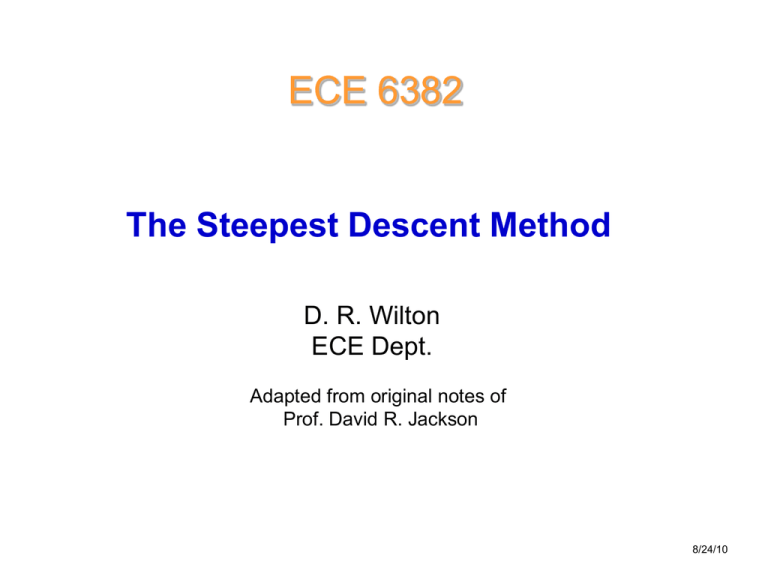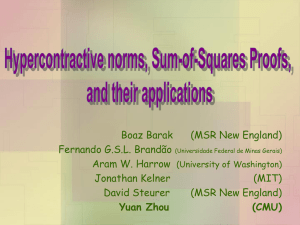Lect12SteepestDescent
advertisement

ECE 6382 The Steepest Descent Method D. R. Wilton ECE Dept. Adapted from original notes of Prof. David R. Jackson 8/24/10 Steepest Descent Method Complex Integral: I f z e g z dz C We want to obtain an approximate evaluation of the integral when the real parameter Ω is very large. The functions f(z) and g(z) are analytic, so that the path C may be deformed if necessary. The steepest descent path (SDP) of interest will pass through a saddle point. Saddle Point: dg g ' z0 dz g ' z0 0 g x z z0 g i y z z0 0 z z0 g g 0 y x Steepest Descent Method (cont.) Path deformation: If the path does not go through a SDP, we assume that it can be deformed to do so. Any singularities encountered during the path deformation must be accounted for (e.g., residue of captured poles). y C z0 C C Cp F z dz 2 i Res F z p X Cp Cp x C Steepest Descent Method (cont.) Let g z u z i v z u v v u (Cauchy Riemann eqs.) i i x x y y all first derivatives vanish at saddle point z z0 ! g ' z0 0 Also, by C.R. conditions, wherever g(z) is analytic, 2u v v 2 x x y y x 2u 2 2u 0 y Steepest Descent Method (cont.) u z0 2u 2u or 2 0 2 x y if uxx 0, then Near the saddle point: u yy 0 “Rubber sheet” models of u(z). 1 2 u x, y u x0 , y0 u xx x x0 2 1 2 u yy y yo u xy x x0 y y0 2 Ignore (rotate coordinates to eliminate) Steepest Descent Method (cont.) The u(x,y) function has a “saddle” shape near the SDP: u ( x, y ) u z0 x y z0 Note: the saddle does not necessarily open along one of the principal axes (only when uxy (x0, y0) = 0). Steepest Descent Method (cont.) Along any descending path (where the u function decreases): I e g z0 f ze g z g z0 dz contribution is from z0 C e g z0 f ze is so large most of i v z v z0 u z u z0 e 0 dz C Note in general, both the phase and amplitude of the integrand change. If we can find a path along which the phase does not change, u z u z the integrand will look like f z e with most of the contribution coming from the neighborhood of z0 . 0 Steepest Descent Method (cont.) Consider a path of constant phase: C0 : v z v z0 constant v z v z0 0 y C0 z0 x This eliminates any variation in the phase term eiv z v z0 inside the integral. Steepest Descent Method (cont.) u(z) landscape near z0: u( z) u( z0 ) y hill valley v( z ) v( z0 ) z0 C0 (SDP) valley hill x u( z) u( z0 ) Steepest Descent Method (cont.) u(z) and v(z) landscape near z0: v( z ) v( z0 ) (SAP) u( z) u( z0 ) y z0 C0 v( z ) v( z0 ) (SDP) x u( z) u( z0 ) Constant phase paths through z0 are also steepest descent paths (SDPs) or steepest ascent paths (SAPs) Steepest Descent Method (cont.) Property: u x, y is parallel to C0 Hence C0 is either a “path of steepest descent” (SDP) or a “path of steepest ascent” (SAP). Steepest Descent Method (cont.) proof u u u x y x y v v v x y x y u v u v u v x x y y u u u u x y y x 0 Hence, Also, v u v C0 (v is constant on C0 ) Hence u C0 y C0 v u x Steepest Descent Method (cont.) Local behavior near SP: 1 2 g z g z0 g z0 z z0 2 1 2 so g z g z0 g z0 z z0 2 Let g z0 R ei R g z0 , arg g z0 z z0 rei 1 i 2 2 g z g z0 Rr e 2 v y z z0 SDP C0 Compare variation of real and imag parts of g(z) - g(z0) above with “landscape” figure near the SP! x Steepest Descent Method (cont.) 1 i 2 2 Rr e 2 0 g z g z0 1 Im g z g z0 v( z ) v( z0 ) Rr 2 sin 2 2 sin 2 0 2 0 or multiples of 2 1 2 u ( z ) u ( z0 ) Rr 2 v( z) v( z0 ) 0 SAP: 2 SAP 0 2 n SAP 2 , 2 SDP: 2 SDP 2 n SDP SDP 2 2 2 2 , 2 2 1 2 u ( z ) u ( z0 ) Rr 2 v( z) v( z0 ) 0 where arg g z0 Steepest Descent Method (cont.) Hence on the SDP, 1 1 j 2 SDP 2 g z g z0 Rr e Rr 2 2 2 z z0 reiSDP Steepest Descent Method (cont.) y u decreases SP 90o SDP SAP u increases SDP x Steepest Descent Method (cont.) u ( x, y ) y x z0 SDP SAP Steepest Descent Method (cont.) Summary: I f z e g z dz C Saddle point (SP) occurs at g ( z0 ) 0 Steepest descent path (SDP) is defined by v( z ) v( z0 ) where v( z ) Im g ( z ) and passes through the SP at an angle of SDP 2 2 with respect to the x - axis where arg g z0 Near SP, SDP is approximately z z0 rei SDP , dz ei SDP dr As increases, contributions to the integral become increasingly concentrated about the SP z z0 : I ~ f z0 e g z0 SDP e 1 R r 2 2 dz Steepest Descent Method (cont.) I ~ f z0 e To evaluate g z0 e 1 Rr 2 2 dz , SDP we note that e 1 Rr 2 2 dz ~ 2e SDP i SDP e 1 Rr 2 2 dr e 0 u x, y y x r0 i SDP 2 R Steepest Descent Method (cont.) y SDP SDP SDP x SAP 2 2 Note: The direction of integration determines the sign. The “user” must determine this. Steepest Descent Method (cont.) Finally, I ~ f z0 e g z0 I ~ f z0 e Recall SDP 2 2 2 iSDP e , R g z0 2 eiSDP g " z0 where arg g z0 Example Bessel function: J0 /2 1 /2 1 cos cos z dz Re I where I /2 / 2 e i cos z dz Hence, we identify: f z 1 g z i cos z g ' z0 0 z0 0 n Example (cont.) y z0 0 x 2 2 g z i cos z g " z0 i cos z0 i arg g " z0 SDP 2 2 4 2 2 SDP 3 or 4 4 Example (cont.) Identify the SDP and SAP: g z i cos x iy i cos x cosh y i sin x sinh y u x, y sin x sinh y v x, y cos x cosh y SDP and SAP: v z v z0 constant cos x cosh y constant cos 0 cosh 0 1 Example (cont.) SDP and SAP: cos x cosh y 1 y SAP Examination of the u function reveals which of the two paths is the SDP. u x, y sin x sinh y C 2 SDP 2 x Example (cont.) The vertical paths are added so that the original path has limits at infinity. y Cv1 C SDP = C + Cv1 + Cv2 It is now clear which choice is correct for the departure angle: SDP 4 SDP 2 SDP 2 Cv 2 x Example (cont.) I ~ f z0 e g z0 2 eiSDP g " z0 (ignoring the contributions of the vertical paths) Hence, I ~ 1 e 2 e I ~ so i cos 0 2 i 4 e j i 4 i 2 4 J 0 ~ Re e 1 Example (cont.) Hence 2 J0 ~ cos 4 Example (cont.) Examine the path Cv1 (the path Cv2 is similar). y Cv1 2 2 / 2 Iv1 / 2i ei cos z dz Let z 2 iy x Example (cont.) 0 I v1 i i i cos jy 2 dy e 0 0 i e sinh y dy i e sinh y dy 0 1 d sinh y e dy cosh y dy Using repeated integration by parts: Note : cos iy sin(iy) i sinh y 2 1 d 1 sinh y e sinh y I v1 i i dy e 0 dy cosh y cosh y 0 1 d 1 1 d sinh y i i e dy dy cosh y cosh y dy 0 1 1 d 1 d 1 i i 2 dy cosh y dy cosh y 0 1 1 1 I v1 i i O( 2 ) Example (cont.) Hence, I v1 1 O If we want an asymptotic expansion that is accurate to order 1/ , then the vertical paths must be considered. Otherwise, we have 2 J0 ~ cos 4







